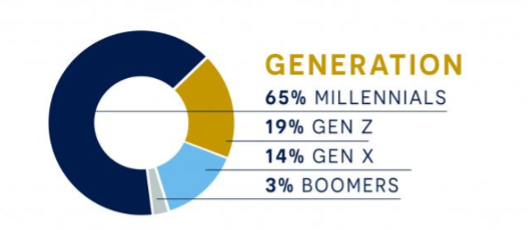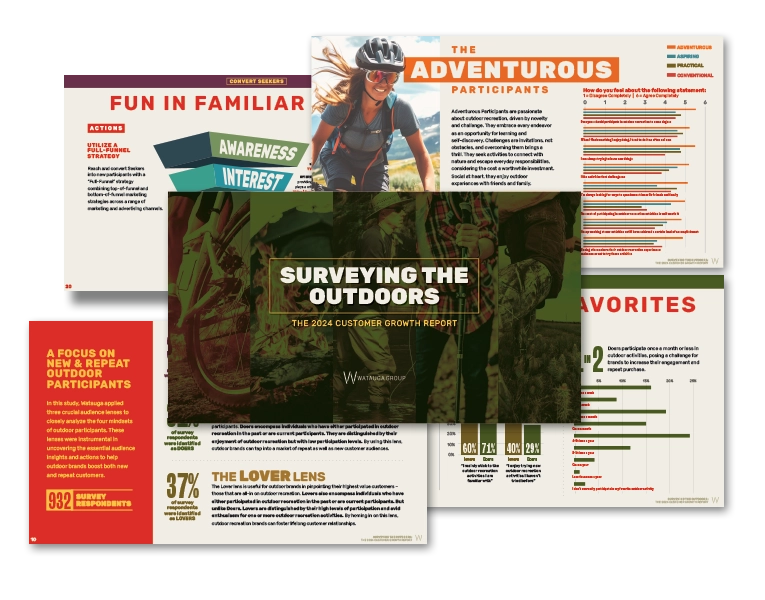It has long been thought that RV (Recreational Vehicles) lifestyle was more suited for older retirees, who have the time and independent lifestyle for consistent recreational travel and the necessary discretionary income to afford a luxury purchase. However, the RV industry is rapidly changing and the number of Gen Z-ers and Millennials choosing to embrace the RV lifestyle has now outpaced the Boomer generation. According to the RV Industry Association (RVIA) latest research, 84% of new RV buyers in 2022 were Millennials and Gen Xers. This new research shows that Millennials have overtaken all other generations by more than double. What is the average age of today’s RV buyers? The RVIA shows that the median age of today’s RV buyer is now 32, a 22% decrease from 2021 and well below where the industry has been in the past.

Not only is the age of new buyers changing, but their motivations are also shifting. While RV buyers are still driven by the desire to experience more road trips, have an outdoor recreation basecamp, or be able to travel in comfort — 39% of them also cited wanting a place to stay while working which is a 17% increase over 2021. Even more impressive is that among current RV owners, 84% of 18-34-year-olds are planning on buying another RV, with 78% of those being a new model.
Reaching Young Adults Using the Right Media at the Right Time
While the young adults that normally purchase RVs are on-the-go, that does not mean this target audience cannot be reached through paid advertising and media. Many RVs have streaming devices, game consoles, and other technology options to keep owners connected, so new RV buyers can adapt their RVs to their media habits.
Watauga’s research shows that reaching this mobile group of RV-ers is best to do through a mix digital channels. Digital channels can be targeted to reach your unique target audience, based on geography, demographics and specific interests in content they have consumed online. Here are a few examples of digital channels that are very effective for reaching the young RV buyer audience:
Streaming Audio and Video
Millennials are 22% and Gen-Z are 30% more likely than average to be listening to streaming audio and 18% and 38% more likely respectively to be watching YouTube. Both audiences are 25% more likely than average to use a video streaming service of some kind. Watauga incorporates streaming and platforms channels into our media strategies and plans to help RV clients maximize the reach of Millennial and Gen-Z audiences that are not watching linear TV or terrestrial radio as much as older generations.
Social
Paid social can be used to reach both audiences, with 37% of Gen Z RV owners and 27% of Millennial RV owners more likely than average to be on Instagram. The older Millennials are 17% more likely to be on Facebook as well. Gen Z RV owners are 663% more likely than average to be on Snapchat and 230% more likely than average to be on Tiktok. Younger RV owners are also engaging with other owners, doing their own research, and chronicling their adventures through social media channels. Watauga recommends having a presence both organically and through paid advertising on social channels to reach users where they engaging with content. All paid social advertising can be targeted not only through geography and demographics, but also based on the interests of the users.
Programmatic Display
With both Gen-Z and Millennials being heavy internet users, other digital channels make sense to add to your media plan. Programmatic display will deliver targeted ads to your consumer wherever they are on the internet and the user can be directed back to content or a website, so they can get more information. Retargeting is another form of display that delivers ads to consumers that have previously visited your website or engaged with your other digital ads. These ads will follow your audience wherever they may be after they have engaged with your brand. Watauga recommends adding programmatic display to your media plans, tailoring your strategy to meet your objectives. Display is an affordable way to extend the reach of your media plan or can be used to drive exposed users to convert through a strong call-to-action.
Reaching Diverse Audiences
Not only is the RV-buying audience getting younger, it is also becoming more racially diverse and attracting more women. In the 2022 North American Camping Report, self-identified non-white individuals and families are now 54% of new RV sales and 1 in 3 Black campers are planning on purchasing an RV in the future. More women are also buying RVs, with an IDS survey of dealers across North American, 65% of respondents cite that between 25-50% of customers at their dealerships are women and 30% of respondents cited between 50- 75%.

Watauga stays on top of these changing trends through our use of multiple syndicated consumer research tools and makes recommendations on the best ways to modify targeting to reach those that are the most likely to make a purchase. It is necessary to have these tools combined with the understanding on how to reach ALL of your audiences. For example, if your media plan only includes Facebook, you will do a great job of reaching women, but not men or any other non-white ethnicity. If you want to be inclusive of all of those audiences, you really need to layer in Instagram AND YouTube. YouTube indexes poorly against women, but does well with men, Black, Asian AND Hispanic audiences. If you are not running on these other channels, you will miss out on a large number of your potential RV buyers.
Conclusion
Understanding the RV demographic is important for RV marketers, particularly for targeting first-time RV owners and those interested in purchasing a new RV. The RV industry is undergoing a significant shift as the demographics of RV buyers change. Millennials and Gen Xers are now the primary purchasers of RVs, with the median age of an RV buyer decreasing by 22% from the previous year. These younger RV buyers have different motivations for purchasing RVs, such as having a place to work remotely while on the road. To reach this mobile target audience, a mix of digital channels such as streaming audio and video, social media, and programmatic display are recommended. Additionally, the RV-buying audience is becoming more diverse, with increasing numbers of women and Asian/Hispanic/Black campers planning to purchase RVs in the future. Adapting targeting strategies to reflect these changes is crucial for companies looking to capture the growing RV market.
[/vc_column_text][vc_column_text]2022 North American Camping Report, RVIA.org
IDS (Integrated Dealer Systems) 2023 Annual Trend Report
RVIA: Go RVing RV Owner Demographic Profile
RVIA: Infographic: Get to Know The 2022 New RV Buyers (“RVIA Infographic: Get to Know the 2022 New RV Buyers”)
2022 MRI-Simmons Fall Doublebase USA






